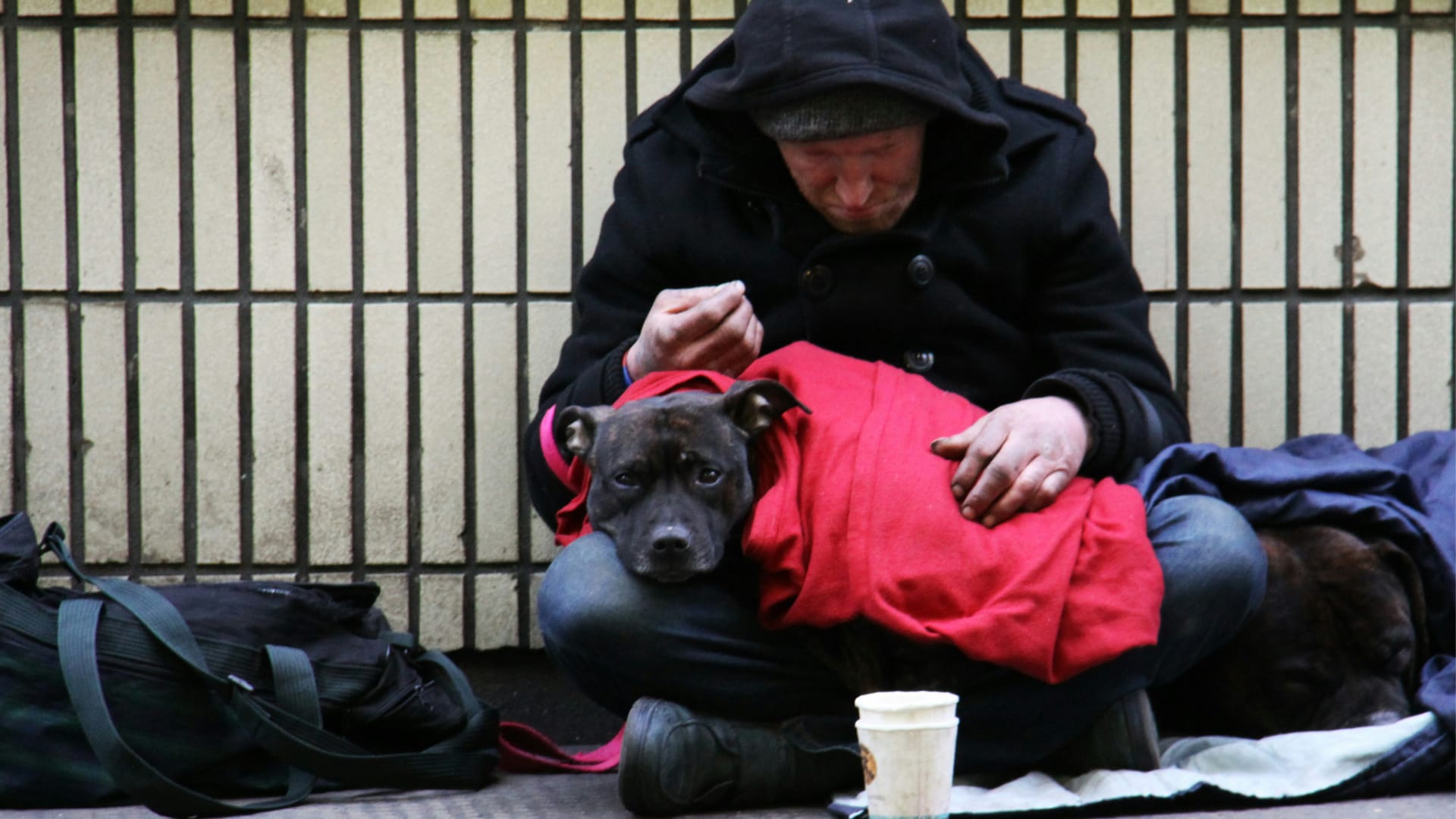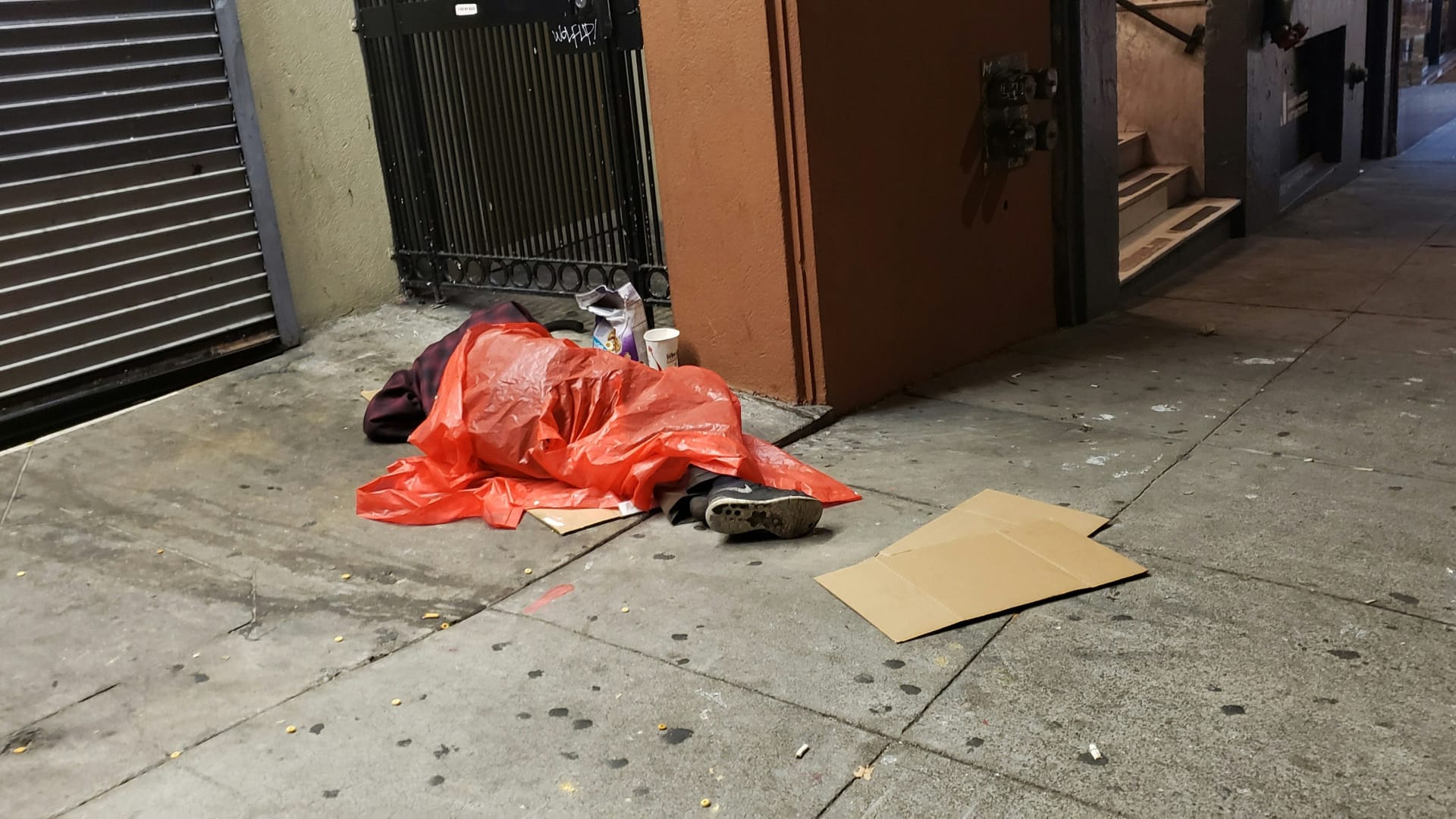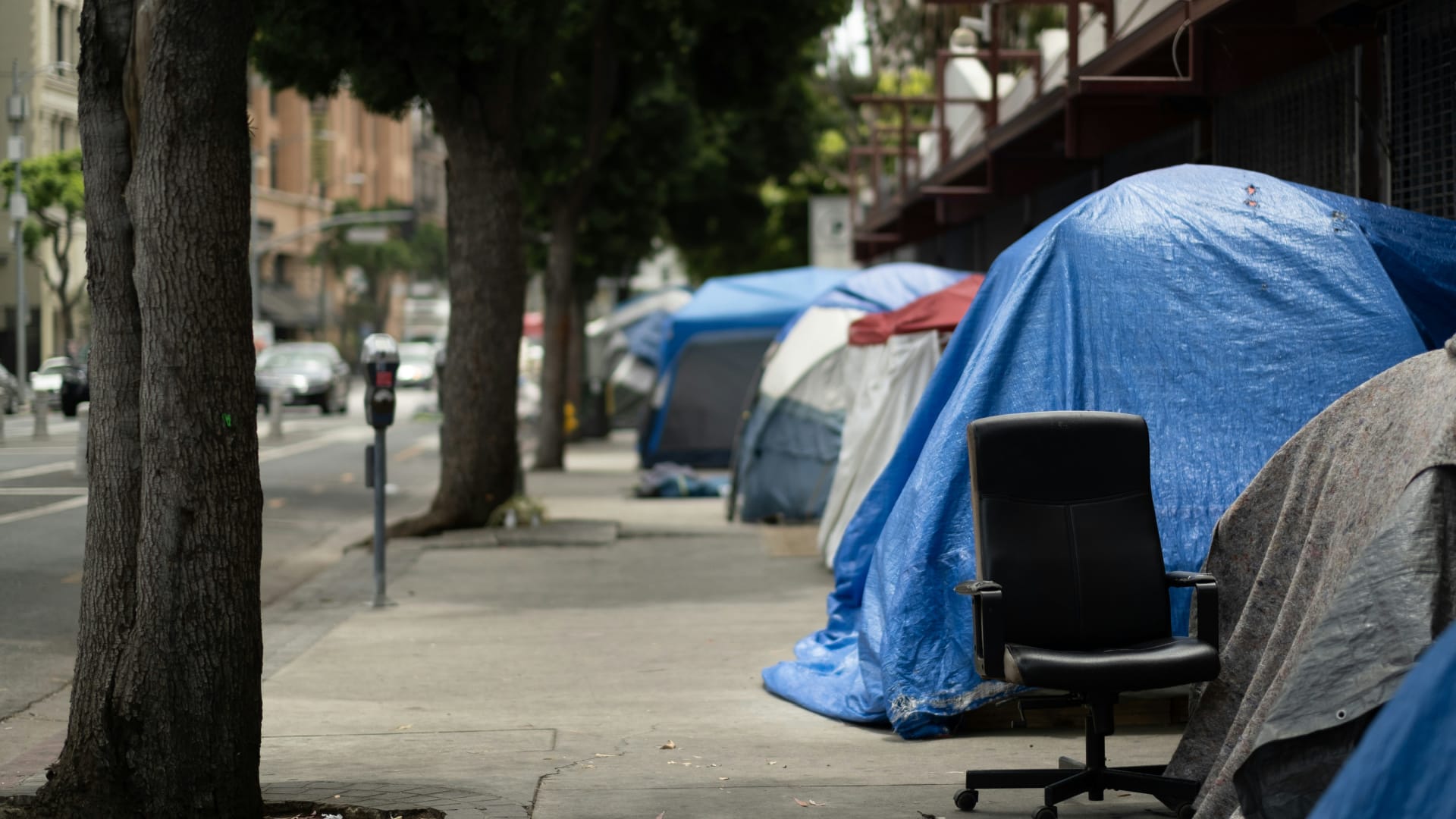Last year, the United States saw its biggest increase in homelessness in decades. The 12 percent spike was dramatic—but maybe not shocking. Homelessness in America has risen steadily for years, and local and state governments have struggled to respond. Some have provided more housing while others have cracked down on encampments. Across the U.S., more than 650,000 people are now homeless. And in June, the U.S. Supreme Court ruled that cities could ban them from sleeping in public.
Just a decade ago, the outlook wasn’t so bleak. Between 2010 and 2016, U.S. homelessness dropped as 87,000 people got off the streets. What’s happened since?
Dennis Culhane, a professor of social policy at the University of Pennsylvania, researches homelessness and assisted-housing policy. As Culhane explains, last year’s unusual rise was largely the result of the crisis that resulted in Texas authorities bussing large numbers of migrants to states with shelter systems that were already near their breaking points. But, he says, it’s also a symptom of government failures. Western states’ unpreparedness and inability to respond were obvious—other problems, less so …
Gustav Jönsson: What happened last year?

Dennis Culhane: It turns out 75 percent of the jump in the American homeless population was in just four jurisdictions: New York, Massachusetts, Chicago, and Denver—with New York, Massachusetts, Illinois, and Colorado being the four states where Texas Governor Greg Abbott sent large numbers of migrants.
In New York, there were more than 29,000 more homeless people in 2023 than in 2022, an increase of 39.1 percent. In Massachusetts, there was a 23.4 percent increase. That’s some 3,600 more people. And in Colorado, there were over 4,000 more, a 38.9 percent increase.
The systems in Massachusetts, where families have a right to shelter, and in New York, where everyone has that right—they were overwhelmed. Demand was huge. Immigrants were living on the streets. So, these governments had to create massive facilities for people to stay in—often big tents. Similarly, in Chicago, homelessness went up by nearly 30 percent—all of it driven by the migrant crisis.
Now, another 20 percent of that increase was on account of chronic homelessness. The rate of exit from homelessness—as the expression goes—has been declining. In other words, lots of people who were once getting out of homelessness are no longer managing to. Rehousing programs can’t keep up. There just aren’t enough new housing units.
Lots of people who were once getting out of homelessness are no longer managing to. Rehousing programs can’t keep up.
In the end, only the remaining 5 percent of that increase was the result of more people becoming homeless.
Jönsson: A little less than a third of all homeless people in the entire U.S. live in California. That’s more than 181,000 people. What makes California such an outlier?
Culhane: Homelessness in California has surged since around 2014. And it’s really not unique to California. The same has happened in Oregon. It’s happened in Washington state. It’s happening now in Nevada and Arizona.
If you look at the trend line across America, what you see is that homelessness declines from 2009 until 2016, and then it looks pretty flat from 2016 to 2018—but that’s in spite of it going up at double-digit rates on the West Coast.
In general, though, the homelessness rates in Western cities aren’t much higher than in the big cities in the Northeast. The rates in Los Angeles and New York, for example, are similar.

What’s dissimilar are the shelter systems. Most homeless people without shelter live on the West Coast. California alone has more or less half the nation’s unsheltered homeless population. In the Eastern, Northeastern, and Midwestern U.S., only a tiny fraction of the homeless population sleeps outside. In Vermont, for example, 96 percent of homeless people have shelter, and in New York, 95 percent of homeless people have shelter.
So, the character of the problem is very different. To respond to a homelessness crisis, there have to be existing shelter and housing systems that can be scaled up—but on the West Coast, these systems weren’t in place. That’s because the states on the West Coast had largely relied on private, charitable relief systems. Basically, these states weren’t ready—and they didn’t respond quickly enough.
Now, they’re trying to catch up. They’re getting more shelters and implementing new housing programs. But the growth is so slow that it’s hard for it to make much of an impact. Last year in Los Angeles, only 12 percent of people in homeless services entered any kind of housing placement.
The homelessness rates in Western cities aren’t much higher than in the big cities in the Northeast. What’s dissimilar are the shelter systems. Most homeless people without shelter live on the West Coast.
Jönsson: Just how much worse is it for homeless people without shelter?
Culhane: Being homeless without shelter has massive negative health effects. Unsheltered homeless people don’t have ready access to clean water or sanitation. They can’t prepare or store food, and they’re not being provided with meals, as someone in a shelter might be. They’re exposed to the elements—and to air pollution. It’s also not unusual for them to be victimized by other homeless people, by thugs, by police, maybe by private security guards. It’s a very, very tough situation to endure.
Jönsson: Homelessness numbers were falling until 2016—and that’s despite the Great Recession in 2008. What explains that?
Culhane: In 2009, three big things happened.
The first was that the U.S. Congress—because of the economic crisis—passed the Homeless Emergency Assistance and Rapid Transition to Housing Act. That reauthorized the McKinney-Vento Homeless Assistance Act, which was the largest source of funding for homelessness-assistance programs.
The HEARTH Act included a number of policy changes that researchers had proposed. It reduced funding for transitional housing, which provides temporary accommodation before giving people somewhere more permanent to live. That’s expensive, inefficient, and can effectively keep people homeless. Instead, the HEARTH Act created a rapid rehousing program to help homeless people get back into permanent homes immediately. And it institutionalized a Housing First policy—meaning that people get permanent housing without first having to meet certain requirements like being sober or employed.

The second was that President Barack Obama created an initiative to end veteran homelessness. Back in 2009, there was a significant rate of homelessness among vets, so Obama launched a program designed both to help them get out of homelessness and to prevent them from becoming homeless in the first place. The initiative included 80,000 permanent housing units. And it worked. Between 2010 and 2016, veteran homelessness was almost cut in half.
And the third thing that happened was that Congress passed the American Reinvestment and Recovery Act. For the first time, the U.S. government created a $1.5 billion national rehousing initiative, called the Homelessness Prevention and Rapid Re-Housing Program. Before, many local governments had only had two ways of fighting homelessness: shelter and permanent housing for the chronically homeless. This gave these communities a new tool: rapid rehousing.
Jönsson: How does that work?
Culhane: Usually a nonprofit reaches out to people living in shelters and identifies what services they might need. Maybe they need help with an immediate health emergency, for example. But the focus is figuring out how to resolve their financial situation: paying unpaid bills, fixing credit histories, things like that. For the most part, it means helping people find an apartment or someone they can live with. Rehousing programs help pay security deposits—that’s usually three months’ payment upfront—and they help pay six, 12, or 18 months’ rent going forward. In some cases, they cover rent for two years.
Being homeless without shelter has massive negative health effects. It’s a very, very tough situation to endure.
Jönsson: Who tends to benefit from rapid rehousing?
Culhane: These programs target people who are employable. People with disabilities, on the other hand, should be getting disability income from the government. Since they’re not ever going to have enough income to afford market rents, they might get supported housing, which is a permanent subsidy. Rapid rehousing, though, targets people experiencing short-term homelessness—about 45 percent of them have a job, and the ones who don’t are usually employable. Their average income is around $6,000-$7,000 when they become homeless. The rehousing assistance supplements that.
Jönsson: Now that homelessness is on the rise in America, how do you see local governments tackling it?
Culhane: Local governments have implemented a lot of programs that just address situational or marginal issues. Situational homelessness is when someone loses their home after some crisis—maybe a job loss, a divorce, a health emergency, or a natural disaster. But there’s evidence showing that it’s housing programs that end homelessness—and the two main programs in the U.S. are permanent supportive housing and rapid rehousing with time-limited subsidies. Both of those programs run at around 85 percent effectiveness—meaning, when people are housed, there’s an 85 percent chance they’ll still be housed one or two years later.

There’s research suggesting both programs work really well. But the U.S. government just doesn’t do enough. Only about 10 percent of homeless people can get into one of these programs; there just aren’t enough slots.
Jönsson: So why doesn’t the government do more?
Culhane: Because the U.S. federal budget has two parts. There are discretionary programs and mandatory programs. By law, Congress must fund mandatory programs, like Social Security; Medicaid, which provides health insurance to people with limited resources; and Medicare, which provides health insurance to the disabled and the elderly.
Discretionary programs are at the will of Congress, though—and Congress often only partially funds homelessness programs. Every year, there’s a big fight about whether to increase funding or not. Even when it increases funding a little above inflation—let’s say, 3 percent, 4 percent, or 5 percent annually—it’s still such a slow growth rate that America’s homelessness programs will never catch up with American homelessness. In the end, Congress usually does increase funding—but never enough.
